Planting fruit-bearing trees take a lot of effort and caring if you want to enjoy a good harvest. Regardless of the kind of fruit tree you have, you need to provide it with good nutrition so it can grow. But aside from knowing the best fertilizer for your fruit trees, you should also know when and how to apply them properly.
When to fertilize fruit trees? Fertilizing fruit trees may start one year after planting them so that they will have a steady growth. Most fruit trees require fertilization at least once a year, particularly every March. But most importantly, conduct a soil test for fertilizer recommendations and to prevent under or over-fertilization.
All fruit trees require 16 elements to keep them healthy, and none of them can replace the other. But as they continue to grow, some of these macronutrients will be lost. Fortunately, you can replace them by applying fertilizers. If you want to learn everything about fruit tree fertilizers, this complete guide can help you.
What Is the Best Time to Fertilize Fruit Trees?
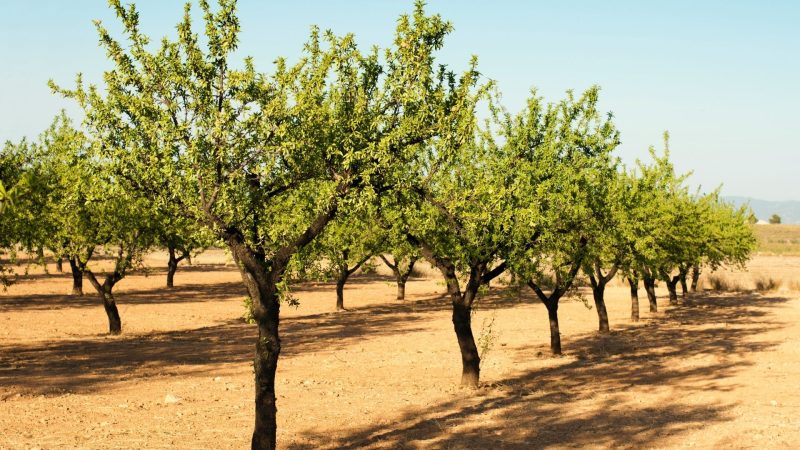
The best time to fertilize fruit trees is in the early spring (March) because this is the time of the year when trees nurture their baby fruits and have just passed winter dormancy. Applying fertilizer in the late part of spring or summer may cause your fruit tree to grow late. They will also be prone to diseases when winter arrives.
How Often Should I Feed My Fruit Trees?
In normal conditions, you should feed your fruit trees every year to maintain their growth and strength against pests and diseases. Nevertheless, some mature fruits may be fed twice a year. But in general, the frequency of fertilizing trees mainly depends on when they need it. Overfeeding trees can damage them.
Organic vs. Synthetic: Which Is the Better Fruit Tree Fertilizer?
Fruit tree fertilizers can be divided into two categories – organic and synthetic. Organic fertilizers are derived from plant or animal sources, including manure, blood meal, fish meal, and others. Meanwhile, synthetic fertilizers are also called inorganic fertilizers because they contain processed minerals or chemical salts.
Organic fertilizers help a lot in increasing soil organic matter, reducing temperature and moisture fluctuations, and improving overall soil health. However, it may take several days (or even weeks) before they will have an effect on fruit trees. They are also more expensive than inorganic fertilizers.
In comparison, synthetic fertilizers provide rapid delivery of nutrients to the plants, especially when they are in liquid form. They are also easy to use for calculating precise nutrient content and application rates. But because they are more soluble than organic fertilizers, there is a higher risk of over-fertilization.
Technically speaking, organic and synthetic fruit tree fertilizers are both effective, although they work differently. But because organic fertilizers are slow-release, it’s better to apply them in the fall instead of early spring. If your fruit trees need higher nutrient levels, you might want to use synthetic fertilizers instead.
What Are the Different Types of Fruit Tree Fertilizers?
Fruit tree fertilizers come in different types and forms. All of them are effective, depending on how to use them. To help you choose the best type of fertilizer for your fruit trees, below is a brief description of each of them, along with their advantages and disadvantages:
1. Granular Fertilizer
Granular fertilizer is a solid, dry fertilizer that is in pallet form and comes in various shapes, sizes, and colors. Dry fertilizer is easy to store, cheaper than the liquid form if you buy in bulk, and more effective for slow-release effects. On the other hand, you need a broadcast or drop spreader, which is an additional cost.
Using a spreader can also be challenging since dry fertilizer is difficult to spread evenly. Another thing, slow-release granular fertilizers have a higher salt content, which is “hot” and can burn your soil once you accidentally spread them. If you want to use granular fertilizer as liquid fertilizer, just dissolve it in water.
2. Liquid Fertilizer
Unlike granular fertilizers, liquid fertilizers are more concentrated and allow plants to absorb nutrients faster. This is because you can spray them directly to the leaves and are, therefore, ideal for in-season application. As compared to ground application, the foliar application is faster in correcting plant nutrient deficiencies.
The liquid fertilizer also contains less salt, which is why it is usually better as a starter fertilizer. Liquid application of fertilizer also results in the uniform distribution of nutrients to the plants. The main disadvantage of liquid fertilizer is that it will eventually evaporate. Aside from that, it is more expensive than the solid form.
3. Powdered Fertilizer
Just like granular fertilizers, powdered fertilizers are also dry and have a higher percentage of active ingredients as compared to the liquid form. You can also sprinkle them around your plants or dissolve them in water. However, plants can easily absorb the nutrients of powdered fertilizers as compared to the solid form.
Powdered fertilizers are also better than liquid fertilizers when it comes to soil amending, and reservoir applications and are significantly cheaper in terms of shipping costs. The only main concern in using any kind of powder is that it takes more effort and time to dissolve it, especially in cold water.
4. Fruit Tree Fertilizer Spikes
Fertilizer spikes consist of tiny capsules placed inside a spike-shaped container. They are being applied to the soil by hammering its cap like a nail, making it very easy and convenient to use compared to the others. This type of fruit tree fertilizer is most effective in soft soil, usually in the spring and fall.
With this strategy of fertilizing fruit trees, the nutrients are being released over time, and the chance of over-fertilizing is minimal. Fruit fertilizer spikes are pre-measured, but the distribution of nutrients to the roots might not be uniform if the spacings between them are wrong. For proper use, read the manual carefully.
What Are the Three Numbers on Fertilizer Package Labels?
You may notice that all fertilizer product labels have three numbers, which are called the NPK values. N stands for the percentage of nitrogen (N), P is for phosphate (P2O5), and K (symbol of potassium) is for potash (K2O). In some cases, there is a fourth number, which represents the percentage of sulfur.
By law, fertilizer manufacturers should reveal the amount of chemicals in their products. For example, a 5-lb pack that has a label of 5-10-5 means that there is 0.25 lb (5%) of nitrogen, 0.5 lb (10%) of phosphate, and 0.25 lb (5%) of potash. If the value is zero, it means that there is no amount for that particular chemical.
How to Use Fertilizers for Fruit Trees? | A Step-by-Step Guide
Different fruit trees have different fertilizing schedules, dosages, and the kind of fertilizers to be used. Below is a step-by-step guide and useful tips for successful fruit tree fertilization:
- Choose a fertilizer based on the recommendations from the soil test results. If a soil test is not performed, follow the instructions on the fertilizer label.
- Apply fertilizer at about 1 foot away around the entire root zone area.
- Water, the trees right after you, apply fertilizers. This is to help nutrients dissolve and penetrate through the roots and to reduce the evaporation of nitrogen.
- Monitor the growth rate of the trees. This will give you an idea of the amount of your next fertilization.
Tips:
- Ideally, the NPK values should be equal. For example, 10-10-10.
- If the area where the fruit trees are planted receives regular fertilization, you don’t need to fertilize the trees.
- Don’t fertilize newly planted trees.
- Don’t apply nitrogen fertilizer in the planting hole.
- Never fertilize fruit trees that are stressed due to drought, heat, and when they are dormant. Instead, give them water.
- If possible, mix fertilizers into the top few inches of the soil.
- For fruit trees, 10 years of age and above, the required maximum amount of nitrogen is 1 lb.
Here is a video on how to fertilize fruit trees:
When Should You Not Fertilize Fruit Trees?
In general, it is not necessary to fertilize fruit trees. Fertilizers are not food for trees and are not also a cure for unhealthy trees. Therefore, healthy trees don’t need fertilizer if the soil has a sufficient amount of minerals or nutrients. Newly planted trees don’t need fertilizer yet unless they become well established.
When to Fertilize Fruit Trees?
As mentioned earlier, fertilization of fruit trees should be done after the soil test. This is to determine the right fertilizer to use and when to apply them. March is the best time to apply fertilizer. Some fruit trees require application only once a year, while others should be fertilized twice or more than thrice a year.
When to Fertilize Cherry Trees?
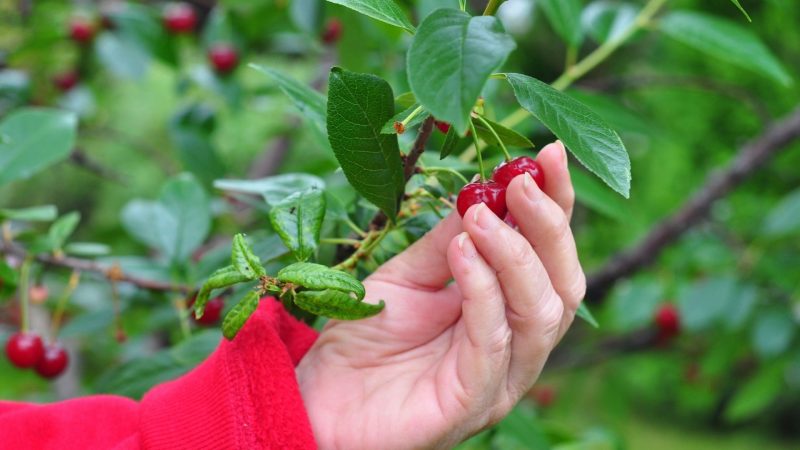
Typically, fertilizing cherry trees is done twice a year. The first half of the application is in March, and the other half is in April. Regardless of the type of tree, applying fertilizer to younger trees is not yet necessary if you have rich soil. After a year of continuous growth, you may now apply low-nitrogen fertilizer.
When to Fertilize Peach Trees?
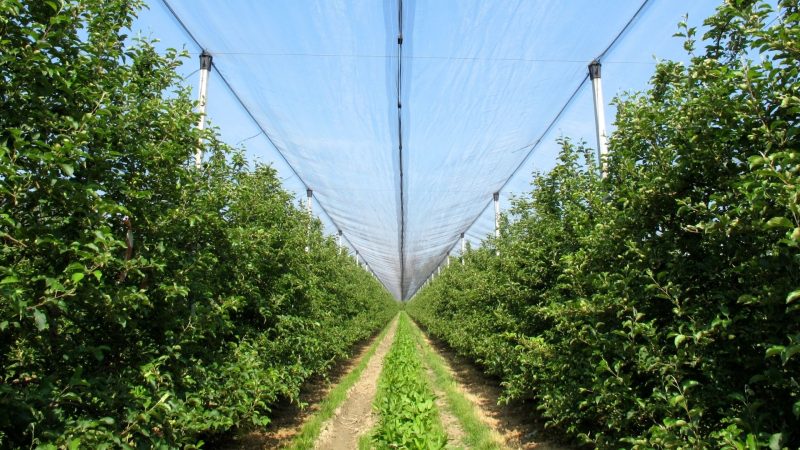
Mature peach trees require less fertilizer because they only produce fruits two years after you planted them. Apply fertilizer twice a year, with the first one in March, just when flowers are starting to bloom, and petals fall. The second one should be in the late spring (May), with the succeeding ones after harvest time.
When to Fertilize Apple Trees?
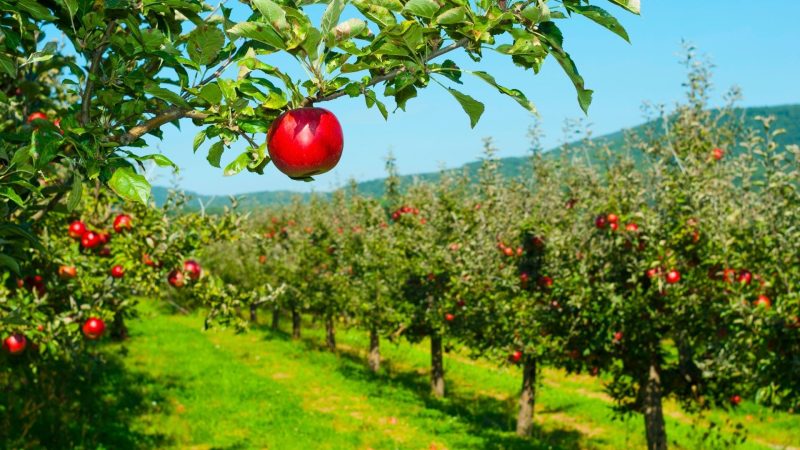
Apply fertilizer to apple trees in March when they are about 1 foot tall. Otherwise, wait for the next spring, or you will be just wasting money. Once the trees are bearing fruits, apply a high-nitrogen fertilizer once a year in the early spring. Stop fertilizing if the growth rate of their branches is already 8 – 12 inches per season.
When to Fertilize Mango Trees?
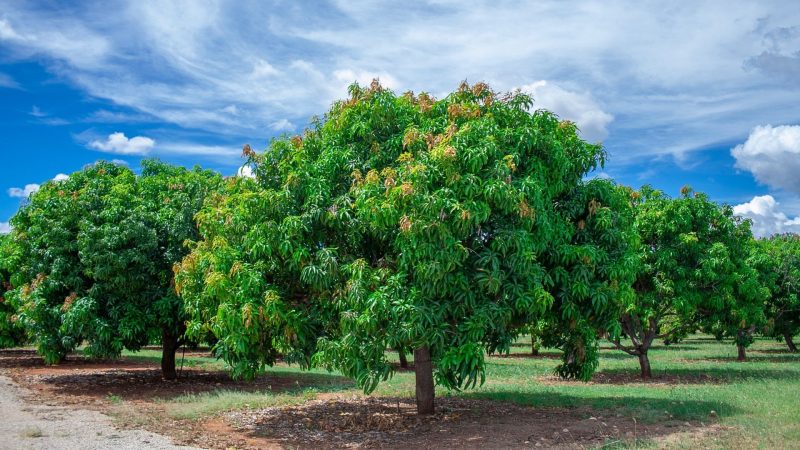
Unlike many other fruit trees, mango trees should be fertilized every 2 – 3 months during their first year. Once they are established, you should fertilize them three times a year – spring, summer, and fall. The application should be made every after harvest time. Its amount depends on the age of the tree and its growth rate.
When to Fertilize Orange Trees?
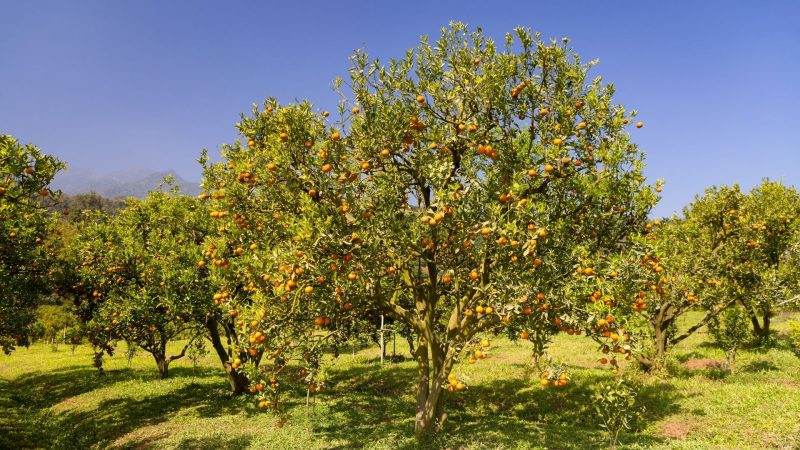
Orange trees should receive fertilization three weeks after planting. During the first year, apply fertilizer every six weeks, from February to September. In their 2nd and 3rd third year, fertilization should be five and four times a year, respectively. For the succeeding years, it should be done three times a year.
Why Are My Fruit Trees Not Producing Fruit?
There are several reasons why your fruit trees are not producing fruits. In some cases, most of them are present and cause your trees to become unproductive. To add to your worries, you will not be able to detect the exact root cause right away. But to give you some ideas, here are some of the most common ones:
1. Over-Fertilization
Over-fertilization means heavy applications of nitrogen, which can make the plant vulnerable to pests and diseases. They will stop growing and will soon die. Among its symptoms are leaf drops, yellowish lower leaves, and blackened or rotted roots. This is also why you should conduct a soil test before applying fertilizer.
2. Excessive Pruning
Pruning is a common practice to remove damaged or dead branches. However, excessive pruning allows pests and diseases to have access to your fruit trees. To avoid this, know which part of your trees that you should not cut.
3. Frost Damage
Frost damage occurs when flower buds are starting to develop. In some cases, flowers may open but will not produce fruit. The major symptoms are damaged leaves when the flowers turn black or dark brown and if the temperature is below 29°F. To avoid this, plant the fruit trees that are compatible with your area.
4. Pollination Issues
Pollination is when pollinators such as bees transfer the pollen from one flower to another so that the trees can bear fruits consistently. Lack or poor pollination means that there are activities that disturb the bees from their activities. This includes rain, cold weather, and, worst of all, improper use of insecticides.
What Are the Best Fruit Tree Fertilizers?
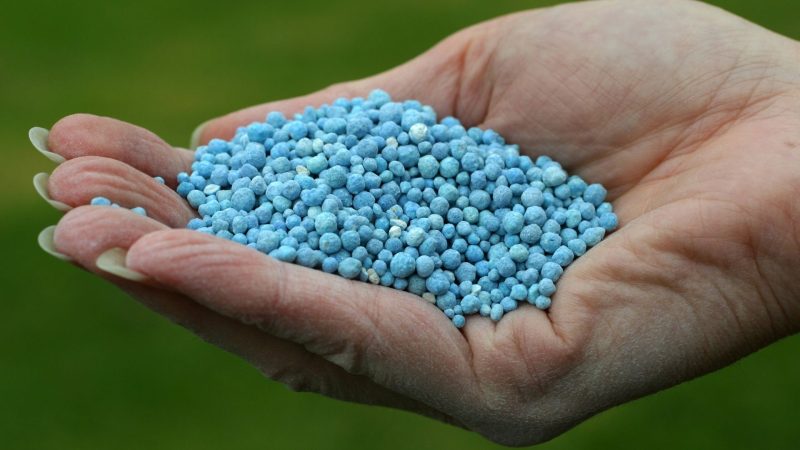
Below is a selection of some of the best fruit tree fertilizers you can choose from. All of them are high-quality products but at very affordable prices. They received high ratings from verified users and enjoyed tons of positive reviews from satisfied customers. Don’t forget to read the instructions before using.
1. Fertilome 10820 Citrus and Pecan Tree Food 19-10-5
Fertilome 10820 Citrus and Pecan Tree Food is a proud product of Voluntary Purchasing Group. As mentioned on the label, this 4-pound fertilizer bag has an NPK ratio of 19-10-5. Aside from that, it has iron, manganese, zinc (3%), and other essential nutrients that can help citrus and other fruit trees grow healthy.
2. Earth Pods Premium Fruit & Citrus Plant Food Spikes 2-2-4
Earth Pods Premium Fruit & Citrus Plant Food Spikes work very well in various dwarf fruit trees, including avocado, banana, lime, and orange. Aside from being compact and eco-friendly, these 100-capsule fertilizer spikes are very easy to use and can be applied in both indoor and outdoor potted flowering fruit plants.
3. Espoma CT4 4-Pound Citrus-Tone Plant Food 5-2-6
Espoma CT4 4-Pound Citrus-Tone Plant Food 5-2-6 is an all-organic formula with thousands of living microbes. This 4-lb slow-release fertilizer pack is ideal for all citrus, nuts, and fruit trees and is perfect for pre-bloom and post-bloom seasons. But because it has a strong smell, better to use it for outdoor plants only.
4. Espoma TR4 4-Pound Tree-Tone Plant Food 6-3-2
Espoma TR4 4-Pound Tree-Tone Plant Food 6-3-2 is also an organic fertilizer with 15 essential nutrients and is ideal for all kinds of fruit trees and ornamental plants. The granules are non-hazardous, eco-friendly, and are not easily blown by the wind. It contains some chicken manure, but the odor is tolerable indoors.
5. Down to Earth Organic Citrus Fertilizer Mix 6-3-3
Down to Earth Organic Citrus Fertilizer Mix 6-3-3 is a completely organic formula with primary and secondary plant nutrients such as calcium, iron, sulfur, and zinc. Among its major ingredients are alfalfa meal, fishbone meal, and feather meal, which are excellent for citrus trees and other fruit trees.
6. Down to Earth Organic Fruit Tree Fertilizer Mix 6-2-4
Down to Earth Organic Fruit Tree Fertilizer Mix 6-2-4 is a great alternative for the 6-3-3 version if you need a different amount of phosphate and potassium. This amazing organic fertilizer is also odorless, has added calcium, and works well with a wide variety of fruit trees, including apple trees, mango trees, and others.
7. Jobe’s Organics 09524 Purpose Granular Fertilizer 4-4-4
Jobe’s Organics 09524 Purpose Granular Fertilizer 4-4-4 is a granular fertilizer with a balanced amount of the main nutrients. This excellent product is enhanced with an exclusive microorganism, Biozome, that assertively breaks down the nutrients to achieve positive results faster. The odor is tolerable, though.
8. Jobe’s Organics All-Purpose Fertilizer Spikes 4-4-4
If you want to get rid of the mess of handling fertilizer, Jobe’s Organics All-Purpose Fertilizer Spikes 4-4-4 is just right for you. This pre-measured, slow-release fertilizer package also contains Biozome and comes with 50 odorless spikes, which means you can apply them both in indoor and outdoor plants.
Summary
Fertilizing fruits may not be as easy as you think, especially for beginners. The key here is to have a full understanding of the kind of fertilizer you need before using them. Lack of fertilizer affects fruit production and tree growth. Over-fertilization does not only affect the trees; it can also contribute to water pollution.
Related: Best Fertilizer for Trees and Shrubs | How to Use Them?
List of Sources
Fertilizing Tree and Small Fruits in the Home Garden
Home Orchards: Why Is There No Fruit on My Tree?